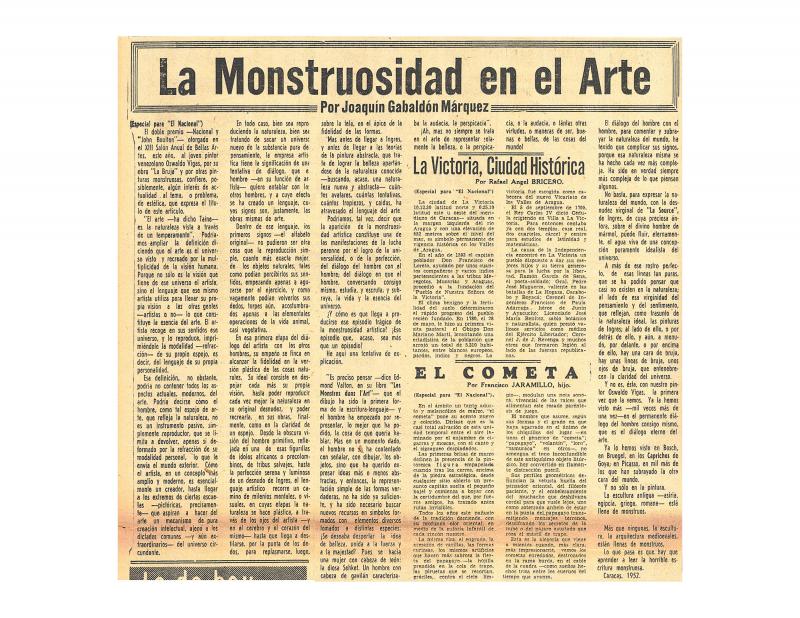On April 14, 1977, Venezuelan journalist Paco Benmamam held an interview with Venezuelan painter Oswaldo Vigas (b. 1926), which was published three days later under the title “Oswaldo Vigas explosivo” [Oswaldo Vigas Explosive] in El Universal. Vigas’s declarations regarding the the topics of the Venezuelan group Los Disidentes (Paris, 1950), foreign influence on local arts, the architecture of Carlos Raúl Villanueva, and abstract and Kinetic art, originated in a debate within the national arts scene. For more than a month, the responses were published from various artists and critics such as Perán Erminy, Jesús Rafael Soto, Omar Carreño, J. R. Guillent Pérez, Mateo Manaure, Luis Guevara Moreno, Juan Nuñand, and Carlos Celis Cepero—the majority of them dissidents—who sought to counteract Vigas’s radical posture. As part of the debate, critic Roberto Montero Castro published this text that defended Vigas’s stance and sought to vindicate figurative art within the Venezuelan arts, in light of the rise of geometric abstraction, and later, Kinetic art. In his review, Montero Castro contributes to the debate an analysis of the issues that were explored by both extremes, and he refocuses the emotional tone of some declarations on the terrain of objective reflection. He notes the historical details that contextualize the movements in dispute with the aim of questioning the “novedad” [newness] of abstract art, at least in Europe. Another highlight is his view on the fundamental problem of “la identidad” [identity] based on what he calls “actitud” [attitude]; as well as the intervention of socioeconomic and political factors that do not necessarily entail isolation or a self-referential stance. In this sense, Montero Castro’s text—and the debate in general—reflect the tensions arising from the development of the cultural scene (autonomous or dependent) and the Venezuelan position as a productive country and generator of other types of dependence. Regarding Vigas’s work, see the text by Marta Traba and those by Roberto Guevara in the ICAA digital archive, “Oswaldo Vigas/Pinturas 1943–1973” [Oswaldo Vigas/Painting, 1943–1973] (doc. no. 1106962) and “Vigas: proceso abierto” [Vigas: Open Process] (doc. no. 1152753), respectively]. Montero Castro interviewed the artist regarding the intrinsic motivations of his work in “Oswaldo Vigas: La lucha por descubrir la identidad americana” [Oswaldo Vigas: The Fight to Discover American Identity](doc. no. 1168108); Lenelina Delgado interviews the artist in “De la pintura al tapiz” [From Painting to Pencil] (doc. no. 1153365); Joaquín Gabaldón wrote on Vigas’s La Bruja [The Witch] in “La monstruosidad en el arte”[Monstrousness in Art] (doc. no. 850831).





